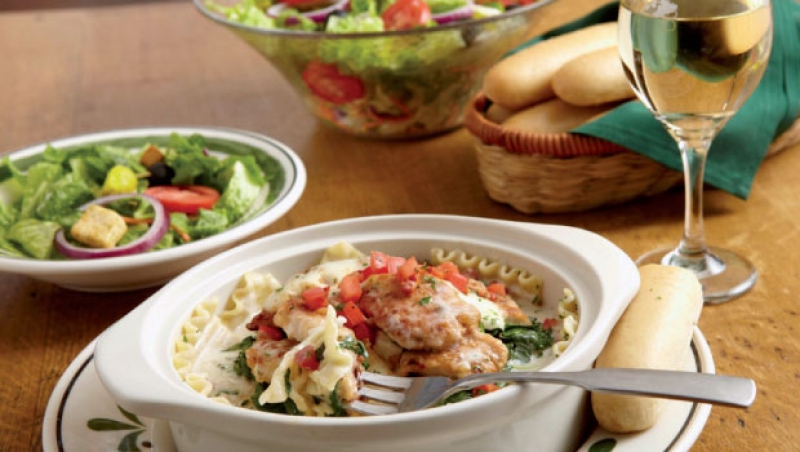Casual dining, where checks average $12 to $50 and there is some alcohol service, is still clawing out of a deep hole that saw customers trading down to quick service and fast casual. However, in 2012 this sector captured sales and unit growth, and continues to reassert itself in the American consumers’ consciousness.
Among the top 10 casual-dining players, the category’s leaders collectively accounted for more than $25 billion in sales and amassed an average sales gain of 4.6 percent, while unit count increased nearly 2 percentage points. Only two—TGI Fridays and Ruby Tuesday—saw a drop in sales.
Those numbers fail to excite ITG analyst, Steve West, who says same-store sales among many major casual-dining brands remain flat amid sluggish traffic.
“We might be seeing overall sales numbers increasing, but that’s being driven by unit growth,” he says. “And we’re seeing higher check averages, but that’s largely because restaurants are passing on higher food costs.”
!chart
*Technomic estimate / Source: 2013 Technomic Top 500 Chain Restaurant Report

Applebee’s
KANSAS CITY, MO Introduced a new design prototype and completed its evolution to a 99 percent frachise-owned business model.
Chili’s Grill & Bar
DALLAS By the end of its current fiscal year, nearly 400 restaurants will carry Chili’s refreshed image.
Olive Garden
ORLANDO In Goldman Sachs’ first quarter Brand Equity Scores, Olive Garden topped all other casual-dining brands with a 70.1 score.
Red Lobster
ORLANDO Began testing fast-casual lunch trial at two Orlando-area locations in March.
Buffalo Wild Wings
MINNEAPOLIS Celebrated 900th store opening in February and expanding into Mexico with three new units this year.
Outback Steakhouse
TAMPA, FL In its Silver Anniversary year, Outback will continue to expand its successful foray into lunch service.
TGI Friday’s
CARROLLTON, TX Sales slumped in 2012, so TGI Friday’s launched aggressive marketing campaigns early this year.
The Cheesecake Factory
CALABASAS HILLS, CA Plans to add eight to 10 new restaurants in 2013.
Texas Roadhouse
LOIUSVILLE, KY Aiming to open 28 restaurants in 2013, including entry into Alaska and Oregon.
Ruby Tuesday
MARYVILLE, TN Unit count is expected to fall further with the shuttering of six to seven company-owned units in 2013.
That said, casual-dining leaders are taking innovative measures to woo America’s discretionary dollars—such as Applebee’s new design prototype and Buffalo Wild Wings’ positioning as the ultimate dining experience for sports and value.
As casual dining’s top headline grabber, Minneapolis-based Buffalo Wild Wings added 71 units in 2012, a nearly 9 percent increase, while a 21 percent increase in sales outpaced all other casual-dining competitors.
“You can get wings anywhere, but Buffalo Wild Wings does a good job of creating a fun, lively atmosphere driven by alcohol sales,” West says, adding that the restaurant’s affordable menu, stable leadership team, first-rate site selection, and strategic event sponsorships have bolstered the brand’s standing.
This year, Buffalo Wild Wings expects to open 60 company-owned units and 45 franchised stores. The company’s steady success continues to capture the interest of investors as well as franchisees, both groups eager to capitalize on the company’s surging momentum.
“Customers like them, operators like them, and they’re dealing from a significant position of strength,” says Technomic’s Mary Chapman.
Texas Roadhouse joined Buffalo Wild Wings as the category’s second concept to record a double-digit sales gain. Inspired by a 6 percent leap in unit count, the steak chain grabbed a 12.4 percent rise in sales.
“Texas Roadhouse is laser-focused on their middle-American target consumer and they deliver for that core customer with their popular bread and hand-cut steaks,” says Jon Jameson, founding partner of the Bellwether Food Group.
Of particular note among casual dining’s top 10, two brands claimed fewer units, but secured sales increases: Chili’s had 13 fewer units operating in 2012 but captured a 2.1 percent sales gain, while Outback Steakhouse notched a 3 percent jump in sales despite being four units thinner.
Brinker International, Chili’s parent company, attributes the chain’s sales improvement to its “Big Rock” initiatives, a series of restaurant-improving efforts that includes product innovation, a strong value proposition, and add-on sales growth. Outback, meanwhile, embraced lunch to propel gains. The steak chain rolled out its weekend lunch program system-wide in 2012, while continuing to slowly add weekday lunch service to its repertoire as well.
Chapman calls casual dining a “take-a-share situation,” saying brands continue doing what they can to increase traffic, including offering hefty promotions and placing a greater focus on other dayparts, characterized by Applebee’s targeting of late-night dining and Outback’s lunch efforts.
Jameson adds that an escalating consumer focus on quality over quantity is leading to struggles at spots like TGI Friday’s and Ruby Tuesday’s as well as gains at differentiated “upscale” casual brands like The Cheesecake Factory, where sales and unit count are both up more than 3 percent.
“I don’t think it’s about two for $20 anymore,” Jameson says. “The folks winning in casual dining are driving business off innovation and increasing value through their experience. That’s the real story going forward.”









